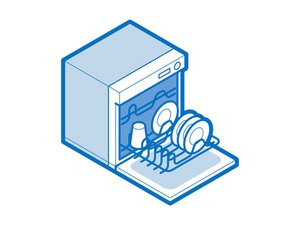Safety First! Before you begin, remember that safety is paramount. Always disconnect your dishwasher from the power source before attempting any repairs or diagnostics. This precaution is crucial to prevent electric shock or damage to your appliance.
Understanding Your Dishwasher This guide covers various problems, from water not entering the dishwasher to issues with drying or leaks. We’ve broken down each problem into three key sections:
- Problem: Identifies the specific issue you're experiencing.
- Why It Happens: Provides a brief explanation of potential causes.
- How to Fix: Offers step-by-step solutions to resolve the issue.
Ready to Tackle the Problem? Armed with this guide, you can approach dishwasher troubleshooting with confidence. Let’s dive in and get your dishwasher running smoothly again!
No Water in Dishwasher
Why It Happens?
The dishwasher might not be getting water due to several reasons like closed water supply, clogged parts, or electrical issues.
How to Fix
- Check if the water supply is turned on.
- Inspect the water inlet valve for voltage and any defects.
- Clean the water valve inlet screen and check for blockages.
- Examine the water fill line for any kinks.
- Ensure the drain hose is installed correctly to prevent water siphoning out.
- Test the door latch switches for continuity.
- Check the float assembly for obstructions and test the float switch.
- For electronic models, run the diagnostic test mode.
- Look for loose or burned wires, and check the float assembly again.
Low Water Pressure
Why It Happens?
This issue could stem from inadequate water pressure or valve issues.
How to Fix
- Confirm water pressure is between 15 and 120 psi.
- Test water volume by filling a quart container in less than seven seconds.
- Clean the water valve inlet screen.
- For portable models, check the aerating snap adapter.
- Test the timer and electronic control for proper functioning.
- Inspect the float switch and adjust or replace if needed.
- Recheck the water fill line for any kinks.
- Refer to the service manual for the correct water level in the tub after the fill cycle.
Poor Washability on the Upper Rack
Why It Happens?
This can be due to issues with spray arms, loading, or temperature.
How to Fix
- Check if the upper spray arm is moving and not clogged.
- Inspect the arm for splits and ensure dishes are loaded evenly.
- Clean the filter assembly and check the lower impeller.
- Confirm water temperature is at 140°F.
- Ensure proper detergent usage and check the dispenser.
- On some models, inspect filters for blockages.
Poor Washability on the Lower Rack
Why It Happens?
Similar reasons to the upper rack, including spray arm or loading issues.
How to Fix
- Ensure the lower spray arm is moving and not obstructed.
- Check for any binding of the spray arm on the housing.
- Verify water temperature and detergent usage.
- Ensure dishes are loaded correctly.
- Check filters on certain models for blockages.
Poor Drying
Why It Happens?
This could be due to low water temperature or malfunctioning components.
How to Fix
- Verify water supply temperature.
- Check the heater, wiring, timer, or electronic control board.
- Ensure correct voltage to the heater and inspect the heater fan assembly.
- Check the use of rinse aid and the level.
- Inspect the door baffle and vent system.
Water Leaking from Front
Why It Happens?
Leaks can occur due to faulty seals, overfilling, or spray arm issues.
How to Fix
- Inspect and clean the spray arm.
- Check the tub gasket and corner gaskets.
- Inspect the vent baffle gasket and corner gasket.
- Ensure no overfilling of water.
- Check door closure and gasket clips.
- Observe the user loading the dishwasher for correct method.
- Verify proper drainage and dishwasher leveling.
- Inspect the door liner and wetting agent dispenser.
Water Leaking at Sides, Top, or Bottom
Why It Happens?
Leaks here might be due to damage or loose fittings.
How to Fix
- Check the side inlet tube and pump assembly for leaks.
- Inspect the motor seals.
- Look for any damage or rust in the tub.
- Ensure tightness of the water inlet port and heater element nuts.
- Tighten all screws in the motor, pump assembly, and upper rack.
Dishwasher Cycle Won't Advance
Why It Happens?
Could be due to electrical issues or mechanical faults.
How to Fix
- Ensure there's voltage to the timer motor or control board.
- Check if the timer cams are rotating.
- Verify correct wiring and check for a jammed timer.
- Test the selector switch and run diagnostic mode.
Detergent Cup Issues
Why It Happens?
Could be due to mechanical or electrical faults.
How to Fix
- For a cup that won't open: Check voltage to the solenoid, inspect for binding, and ensure no dishes block the door.
- For a cup that won't close: Inspect the actuator, cams, and ensure proper adjustment.
Motor Issues
Why It Happens?
Electrical problems or physical obstructions can cause motor issues.
How to Fix
- For a non-operating motor: Check continuity at the windings, voltage to the motor, and for obstructions.
- For a motor going into overload: Check the relay, pump assembly, voltage, polarity, and motor windings. Test the run capacitor if present.
Door Liner Hits Tub in Undercounter Models
Why It Happens?
Misalignment or incorrect installation.
How to Fix
- Check if the tub is square and correct installation issues.
Dishwasher Won't Start
Why It Happens?
Power supply issues or faulty controls might be the reason.
How to Fix
- Check electrical connections, door switch, selector switch, timer, and control board.
- Inspect wiring on the timer and switches.



6 Yorum
Poor Washability on the Upper Rack
Where the filter located?
MARIO BOILY - Yanıt
Mon lave-vaisselle Fisher Paykel à deux tiroirs, celui du haut ne semble plus reconnaître que la porte est fermée et ne veut plus démarrer. Comment réparer ou faire un bypass du système d’oeil magic, ou capteur de la porte??? Je ne trouve aucun schéma du système sur internet.
Jos De Blois - Yanıt
Minha maquina inicia mas não mete água. Porem enchi ela com água manualmente e consegue retirar água, a os filtros estão completamente limpos, e a torneira tem agua e pressão, mas água não esta chegando dentro da máquina
Hector Arruda - Yanıt
A Lava louça não está ligando no Botão INICIA.
LUIZ NERI KARLOH - Yanıt
Istruzioni per cambiare la guarnizione dello sportello anteriore
giancarlo piazzetti - Yanıt